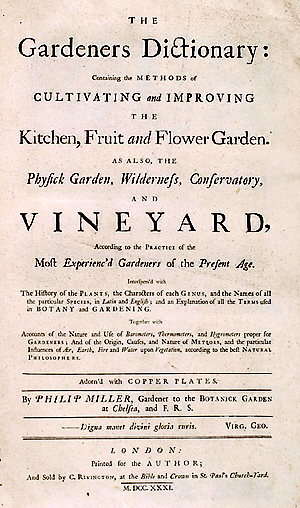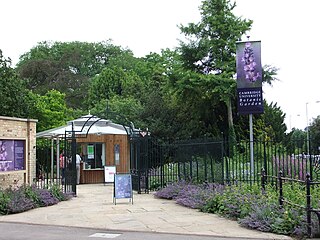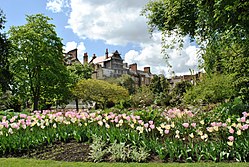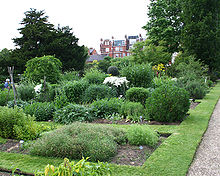
Joseph Banks, 1st Baronet, was an English naturalist, botanist, and patron of the natural sciences.

A botanical garden or botanic garden is a garden with a documented collection of living plants for the purpose of scientific research, conservation, display, and education. Typically plants are labelled with their botanical names. It may contain specialist plant collections such as cacti and other succulent plants, herb gardens, plants from particular parts of the world, and so on; there may be greenhouses, shadehouses, again with special collections such as tropical plants, alpine plants, or other exotic plants.

Sir Hans Sloane, 1st Baronet, was an Anglo-Irish physician, naturalist, and collector, with a collection of 71,000 items which he bequeathed to the British nation, thus providing the foundation of the British Museum, the British Library, and the Natural History Museum, London. He was elected to the Royal Society at the age of 24. Sloane travelled to the Caribbean in 1687 and documented his travels and findings with extensive publications years later. Sloane was a renowned medical doctor among the aristocracy, and was elected to the Royal College of Physicians at age 27. Though he is credited with the invention of chocolate milk, it is more likely that he learned the practice of adding milk to drinking chocolate while living and working in Jamaica. Streets and places were later named after him, including Hans Place, Hans Crescent, and Sloane Square in and around Chelsea, London – the area of his final residence – and also Sir Hans Sloane Square in his birthplace in Northern Ireland, Killyleagh.

The Wardian case was an early type of terrarium, a sealed protective container for plants. It found great use in the 19th century in protecting foreign plants imported to Europe from overseas, the great majority of which had previously died from exposure during long sea journeys, frustrating the many scientific and amateur botanists of the time. The Wardian case was the direct forerunner of the modern terrarium and vivarium and the inspiration for the glass aquarium. It is named after Nathaniel Bagshaw Ward (1791–1868) of London, who promoted the case after experiments.

John Bartram was an American botanist, horticulturist, and explorer, based in Philadelphia, Pennsylvania, for most of his career. Swedish botanist and taxonomist Carl Linnaeus said he was the "greatest natural botanist in the world." Bartram corresponded with and shared North American plants and seeds with a variety of scientists in England and Europe.

The Worshipful Society of Apothecaries of London is one of the livery companies of the City of London. It is one of the largest livery companies and ranks 58th in their order of precedence.
The London Museums of Health & Medicine is a group that brings together some of the activities of several museums in London, England, related to health and medicine. The group was founded in 1991.

Philip Miller FRS was an English botanist and gardener of Scottish descent. Miller was chief gardener at the Chelsea Physic Garden for nearly 50 years from 1722, and wrote the highly popular The Gardeners Dictionary.

The Cambridge University Botanic Garden is a botanical garden located in Cambridge, England, associated with the university Department of Plant Sciences. It lies between Trumpington Road to the west, Bateman Street to the north and Hills Road to the east.

The Royal Botanic Garden Edinburgh (RBGE) is a scientific centre for the study of plants, their diversity and conservation, as well as a popular tourist attraction. Founded in 1670 as a physic garden to grow medicinal plants, today it occupies four sites across Scotland—Edinburgh, Dawyck, Logan and Benmore—each with its own specialist collection. The RBGE's living collection consists of more than 13,302 plant species, whilst the herbarium contains in excess of 3 million preserved specimens.

Nathaniel Bagshaw Ward was an English doctor who popularised a case for growing and transporting plants which was called the Wardian case.
William Hudson FRS was a British botanist and apothecary based in London. His main work was Flora Anglica, published in 1762. He was elected a fellow of the Royal Society in 1761.
William Houstoun (1695?–1733) was a Scottish surgeon and botanist who collected plants in the West Indies, Mexico and South America.
James Petiver was a London apothecary, a fellow of the Royal Society as well as London's informal Temple Coffee House Botany Club, famous for his specimen collections in which he traded and study of botany and entomology. He corresponded with John Ray and Maria Sibylla Merian. Some of his notes and specimens were used by Carolus Linnaeus in descriptions of new species. The genus Petiveria was named in his honour by Charles Plumier. His collections were bought by Sir Hans Sloane and became a part of the Natural History Museum.

Georg Dionysius Ehret was a German botanist and entomologist known for his botanical illustrations.
Thomas Moore was a British gardener and botanist. An expert on ferns and fern allies from the British Isles, he served as Curator of the Society of Apothecaries Garden from 1848 to 1887. In 1855 he authored The Ferns of Great Britain and Ireland. The standard author abbreviation T.Moore is used to indicate this person as the author when citing a botanical name.
Events from the year 1673 in England.

A physic garden is a type of herb garden with medicinal plants. Botanical gardens developed from them.
Isaac Rand (1674–1743) was an English botanist and apothecary, who was a lecturer and director at the Chelsea Physic Garden.
















